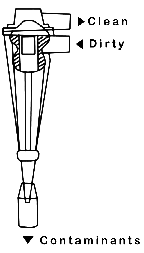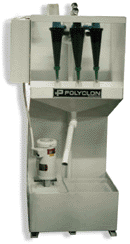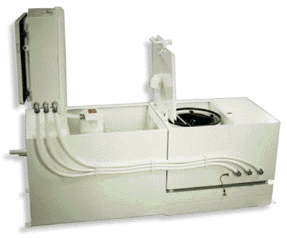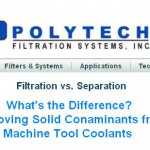
Environmentally Conscious? Then Green Filtration Is For You!
![]() Being environmentally conscious nowadays is crucial, and often a requirement for some of us in certain areas with regulation laws, and enticing tax break incentives to “Go Green”! In light of last week’s Earth Day, here we are going to discuss Polytech’s multiple “Green Filtration” solutions! Our Whirlstream® Hydrocyclone, Conveyor Dragout, and Centrifuge systems provide a low-energy, yet effective filtration process to meet your application needs.
Being environmentally conscious nowadays is crucial, and often a requirement for some of us in certain areas with regulation laws, and enticing tax break incentives to “Go Green”! In light of last week’s Earth Day, here we are going to discuss Polytech’s multiple “Green Filtration” solutions! Our Whirlstream® Hydrocyclone, Conveyor Dragout, and Centrifuge systems provide a low-energy, yet effective filtration process to meet your application needs.
Polytech’s Hydrocyclones offer: Centrifugal Separation of Heavy Granular Solids; Flow Rates of 20 GPM to over 1,000 GPM; High Separation Efficiency; No Filter media consumption, and are available with optional dragout conveyors for heavy solid removal.
But how do they work you ask?! With Hydrocyclones, contaminated liquid enters the hydrocyclone at high velocity through the inlet opening. From there the liquid flows into the whirl chamber. As the liquid swirls downward in the conical separation chamber, its velocity increases.


Photo Credit: www.polytech-filtration.com
Solid contaminants are thrown against the walls, forced to the bottom, and discharged through a nozzle. As the whirling cleaned liquid approaches the bottom, it is unable to exit the restricted discharge nozzle. It then reverses direction, forms an inner vortex and seeks the clean liquid outlet. Due to their high flow rates of up to 1,000 GPM, high separation efficiency, and the fact that Hydrocyclones require no filter media, they are our personal favorite as an Eco-Friendly, Green Filtration solution! Learn more about Hydrocyclone for separation of of solids from machine tool coolant in our published Technical Article, here!
On the other hand, our Centrifuge Systems provide excellent separation of very fine contaminants from water and low viscosity oil based coolants. They provide flow rates of 20 GPM, and help to minimize filter media consumption in cartridge or stacked disc filter systems for low micron or sub micron filtration applications.


Photo Credit: www.polytech-filtration.com Replaceable Bowl Liners speed and facilitate
contaminant removal and disposal.
Centrifuge systems works best for applications having to do with: Surface Grinding (Fine: < 16 rms); End Mill Grinding; Abrasive Slicing; Honing, Lapping & Super-finishing; Vibratory Finishing; Glass & Ceramics, as well as Diamond & CBN Abrasive Machining.
Additionally, Polytech’s Conveyor Dragout systems offer: Reliable, economical removal of contaminants which settle out rapidly without using any filter media; reduced maintenance commonly associated with settling tanks; double dragouts with extended dwell time for enhanced settling, and effective means of de-aerating and pre-filtering grinding oils. Because Conveyor Dragouts do not use any filter media, they are one of the most environmentally friendly options that we offer, however, they are not as effective time wise, or separation wise as the Whirlstream® Hydrocyclones.
 Photo Credit: www.polytech-filtration.com
Photo Credit: www.polytech-filtration.com
We have a variety of sizes and capacities to suit most applications. Conveyor Dragouts are best used in applications regarding: Both Rough (63 rms & above) and Medium (32-16 rms) Surface Grinding; Cutoff saws; Glass and ceramics; Broaching, hobbing, and trepanning; Gear hobbing; Boring and drilling; Chucking and milling, along with turning, lathes, and machining centers.
It is always a good idea to “go green”, however, many states such as California regulate environmental output, and offer companies a tax break as an incentive for using eco-friendly manufacturing and machinery methods. We found this “Clean Technica” article about Green Manufacturing very informative and interesting, if you would like to learn more about what being eco-friendly in the manufacturing workplace exactly entails. They state it pretty accurately– “The term ‘green’ manufacturing can be looked at in two ways: the manufacturing of ‘green’ products, particularly those used in renewable energy systems and clean technology equipment of all kinds, and the “greening” of manufacturing — reducing pollution and waste by minimizing natural resource use, recycling and reusing what was considered waste, and reducing emissions.” – http://bit.ly/1SwNIHe
Here, we are talking about the latter– the “greening” of manufacturing and filtration, where we are reducing pollution and waste (i.e. disposable filter paper media) by minimizing natural resource use. Without the use of (or reduced use of) filter media in our Hydrocyclones, Centrifuges, and Conveyor Dragouts, green filtration is attainable with recycling and reusing.
If you are interested in learning more about Polytech’s Hydrocyclones, Conveyor Dragouts, or Centrifuge Systems, (or some of our other ‘non-green filtration systems’) please feel free to contact us, via our website, telephone, or email, filters@polytech-filtration.com, and one of our skilled and experienced engineers will guide you through choosing the best solution for your application needs!
Filtration vs. Separation
Industrial Coolant Filtration and Manufacturing terminology isn’t exactly a language that comes native to everyone. Here, we will briefly discuss the differences between filtration and separation, to shed some light and understanding on the details unique to each technique, and some applications that best suit them!
First off… some background! Solid contaminants are removed from metal working fluids and coolants by either filtration, or separation. While the terms filtration and separation are often used interchangeably, there are important differences which must be understood and considered when selecting equipment for a particular application. Polytech has a published Technical Article that extensively outlines the details of the differences between Filtration and Separation… however, here is the abridged version!
Separation uses the physical characteristics of the solids to remove them from the liquid. The two principal means of solids separation in coolants and metal working fluids are gravity separation and magnetic separation. The appeal of separation is its simplicity, but, as with most things, the devil is in the details. The key to effective separation is that the separating force must overcome the resistance of the liquid to the movement of the contaminant within the time available.
In a tank or pond heavier solids settle out of suspension. If the pond is still, even very fine particles settle out eventually. Most people can’t afford to have their fluids sitting around, so the model is more like a flowing stream and the rate of settling becomes paramount. Just as a stream runs clear at low flows and carries off rocks during flood, the dwell time or turnover rate in a coolant tank is an important measure of separation as a viable option. In general, if the bulk of the solids will settle out of suspension in 10 to 20 minutes, gravity separation and settling may be a good option.
Of course success comes at a price. Good separation systems soon fill with solids so a means of removal is necessary. Labor on all but the smallest, simplest systems generally precludes manual clean out so a drag conveyor may be needed to remove solids.
Learn more about the characteristics of separation, here.
Filtration involves passing the liquid through some material to remove the contaminants. Filtration has two essential elements. A barrier material the liquid can pass through (filter media) and a difference in pressure between the two sides of the filter material to move the liquid. The type and format of filter media and the means of applying the differential pressure define the basic filter system. The filter media, the characteristics of the solid contaminants, the required coolant flow rates and the available differential pressure all influence filter sizing. In coolant filtration the differential pressure is usually applied by gravity, atmospheric pressure (vacuum filters) or pump pressurized systems.
Gravity filter systems utilize the head pressure of a pool of liquid to create the higher pressure with differential pressures of 0.2 – 1 PSI. Vacuum filters create a lower pressure beneath the filter media so that the atmosphere, at 14.7 PSI, forces liquid through the media . Air blower vacuum systems can provide 2 PSI differential pressure. Centrifugal pump suction based vacuum filters can provide up to 5-6 PSI differential pressure. Kinetic fluid pump based vacuum filters can provide up to 13 PSI differential pressure. Pressure filters start at 15 – 20 PSI differential and in special cases go up to as much as 250 PSI differential pressure.
Learn more about the characteristics of filtration, here.
And there you have it! Separation uses the physical properties of the material itself to isolate contaminants, and filtration uses some kind of a barrier (e.g. Filter Media) that selectively allows permeability to isolate the waste. It’s important to notate the differences when selecting the appropriate solution for your filtration needs, to ensure optimal productivity and efficiency depending on your application. To learn more about Polytech’s filtration solutions, check out our detailed Selection Guide, which allows you to choose and learn more about the proper machine or device by your operation, and coolant type. Thanks for reading!
